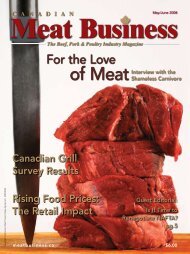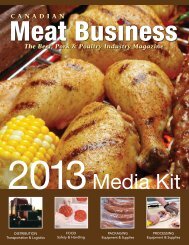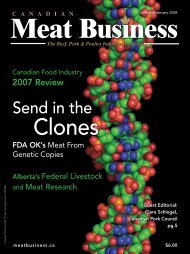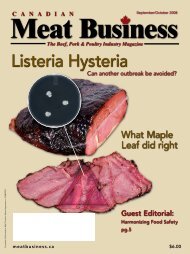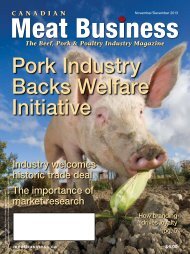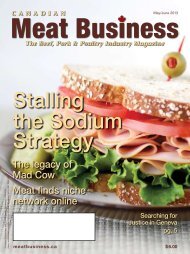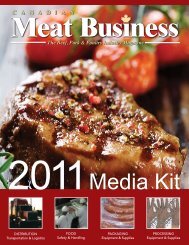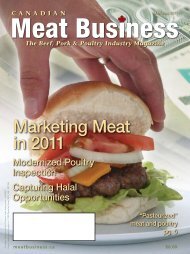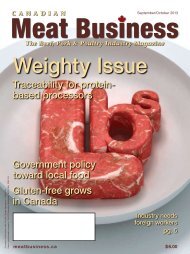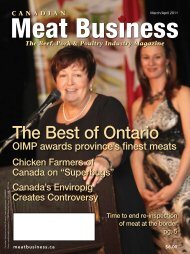Ralph Cator
Joining Meat Hall's Class of 2010 - Canadian Meat Business
Joining Meat Hall's Class of 2010 - Canadian Meat Business
Create successful ePaper yourself
Turn your PDF publications into a flip-book with our unique Google optimized e-Paper software.
LifeStudies<br />
Challenge and Shelf<br />
Testing for the worst-case scenario, and pushing the limits of your<br />
food product.<br />
By Dawn Van Dam<br />
D<br />
etermining how your<br />
product reacts to microbial<br />
contamination and confirming<br />
shelf life provides invaluable information<br />
to the food industry in terms of product<br />
quality and safety. Challenge and shelf<br />
life studies provide this information by<br />
evaluating a product over the course of<br />
the intended shelf life.<br />
Challenge studies<br />
Drills are an essential component<br />
of safety; fire drills, lifeboat drills, CPR<br />
drills...their merit is unquestioned. The reason: learning<br />
how to deal with the worst-case scenario – safely. Challenge<br />
studies are of the same nature. They allow food producers<br />
to reduce risks to food safety by preparing for the worst-case<br />
scenario.<br />
Challenge studies are similar to shelf life studies in that<br />
they examine how microorganisms in a product change<br />
over time. The main difference is that in a challenge study<br />
the product is purposefully inoculated with pathogens,<br />
simulating a chance contamination.<br />
There are two types of challenge studies. The type<br />
known as an inactivation study determines the ability of a<br />
processing step or formulation to ‘inactivate’ the growth<br />
of pathogens of concern (pathogens that historically have<br />
been identified as a risk for a certain type of product). For<br />
example, physical processes such as heating, irradiation and<br />
high pressure treatments can ‘inactivate’ pathogens in a<br />
product.<br />
The other type of challenge study is called an inhibition<br />
study. This type of study confirms the success of a specific<br />
formulation and/or packaging strategy in inhibiting<br />
the growth of pathogens of concern. For example, the<br />
application of sodium acetate or diacetate has been shown<br />
to inhibit the growth of listeria during post-processing steps.<br />
For products like ready-to-eat meats, the application of<br />
antimicrobial additives can decrease the risk to consumers.<br />
So, with challenge studies you can determine how well<br />
your product stands up against microbial contamination.<br />
Shelf life studies<br />
While challenge studies address the issue of chance<br />
contamination, shelf life testing determines the length of<br />
time that a food product will maintain its quality before it<br />
begins to spoil.<br />
As a means of providing consumers with the most reliable<br />
information about the lifespan of a product, and as a measure<br />
of the success of your shelf life-extending strategies, these<br />
studies provide invaluable information to the food industry.<br />
Consumer preferences have shifted towards labels such<br />
as ‘no additives or preservatives’ or<br />
‘no sugar/sodium added.’ The food<br />
industry is continuously looking for<br />
new ways to preserve the freshness and<br />
quality of food over an extended period<br />
of time without the addition of such<br />
additives. Shelf life studies evaluate the<br />
efficacy of new technologies/methods<br />
for extending shelf life, so you can<br />
maintain product quality while adapting<br />
to consumer demands.<br />
Periodic reexamination of shelf life<br />
can also determine if changes made<br />
in your manufacturing process, such as new materials or<br />
suppliers, or new equipment or formulations have affected<br />
the microbiological profile and changed the shelf life.<br />
Shelf life studies are not simple step-by-step procedures;<br />
they rely heavily upon the experience and expertise of the<br />
scientists involved. Each individual shelf life study must<br />
be designed to reflect the unique conditions of a product<br />
including pH, moisture and temperature. Microbial<br />
examination is then conducted over the course of the<br />
intended shelf life, or even beyond to determine the point of<br />
spoilage. Ultimately, consumers use their senses to determine<br />
whether or not a product is desirable, but microbial growth<br />
can reach unsafe levels before any unpleasant changes are<br />
noted.<br />
Evaluating shelf life can help you identify and minimize<br />
risks, determine the most effective methods to prolong your<br />
products’ freshness or marketability, and provide information<br />
to consumers about the lifespan of your product.<br />
University of Guelph<br />
The University of Guelph, Agriculture & Food Laboratory<br />
(AFL) offers customized studies that provide reliable results<br />
and information on how your products react to microbial<br />
contaminations, and how to confirm the shelf life of your<br />
products. When it comes to protecting consumers and brand<br />
names, accurate results are paramount. The AFL is supported<br />
by an integrated quality management system that achieves<br />
the ISO 9001:2008 and ISO/IEC 17025 international quality<br />
standards as well as for specific tests listed on our Scope of<br />
Accreditation, and is happy to work with you to customize<br />
studies, providing the scientific support you need to have<br />
peace of mind.<br />
For more information about conducting shelf life or<br />
challenge studies, you can reach AFL at 519-767-6299 or<br />
1-877-863-4235 (1-877-UofG-AFL), or through email at<br />
aflinfo@uoguelph.ca.<br />
Dawn Van Dam is the Chief Marketing Officer for the University of<br />
Guelph, Laboratory Services, Agriculture & Food Laboratory.<br />
16 Canadian Meat Business September/October 2010 meatbusiness.ca



